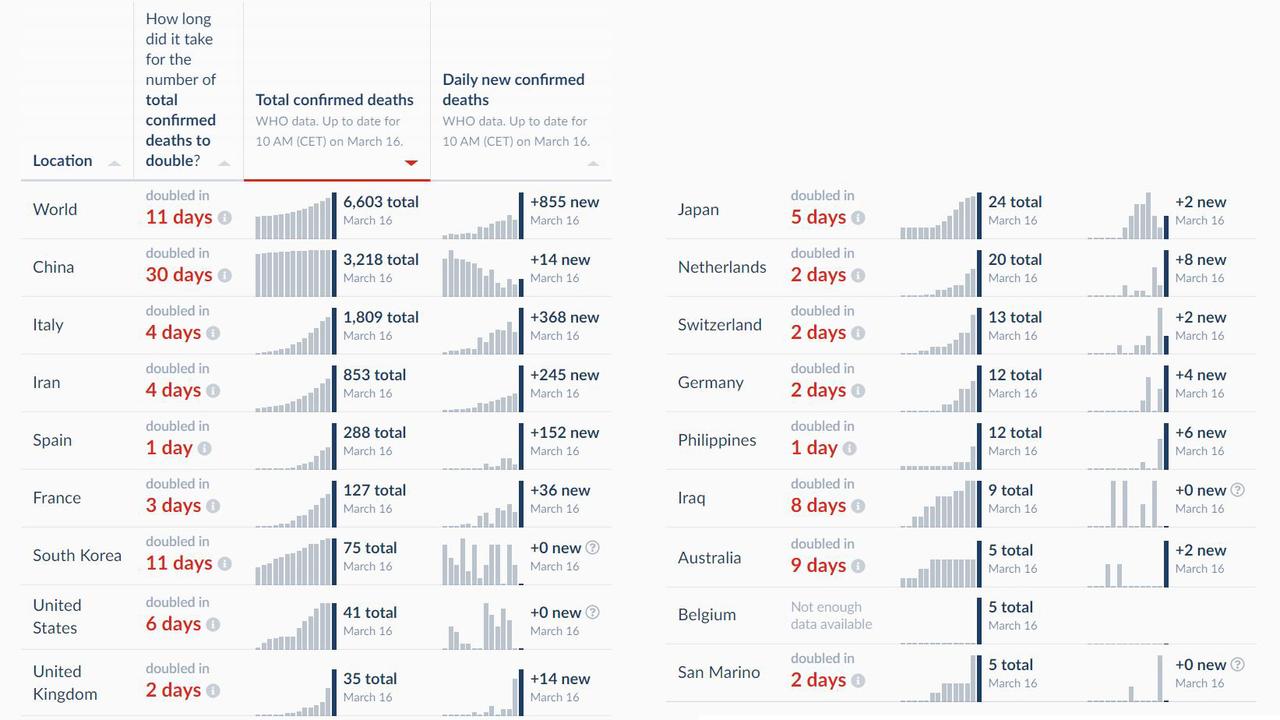Coronavirus: Exponential growth explains terrifying spread of virus
At first, it seemed like coronavirus wasn’t something to panic about – now we’re on track to hit 1 million cases in 66 days. Here’s why.
ANALYSIS
Maths is scary but ignoring maths is scarier, and COVID-19 maths is terrifying.
Which is why it’s past time we all get to grips with exponentials. There are a lot of numbers floating around with this pandemic virus outbreak — stock market movements, risk percentages, infection rates, numbers of sick, and death tallies. In a stand-alone sense, these figures are scary but they are acceptable.
At the time of writing, Australia has more than 530 confirmed cases of the virus and six deaths. But this must be put into context.
We’ve arrived at that number eight weeks after the first recorded arrival of COVID-19 in the country.
At first, nothing much happened and efforts were made to slow it reaching the general community. Then at some unknown point, the inevitable happened, and this is where the mathematical principle of exponential growth kicks in.
COVID-19 began doing what viruses do, it began to replicate. The bubble of new cases became a trickle, then a stream, and it’s still gathering force. And that only represents the number we know.
COVID-19 has spread quietly because it is contagious in the 5 to 14 days it takes before symptoms emerge. This means the number of infected is likely twice the known count and that’s before “guesstimates” are applied to encompass those suffering only mild symptoms.
Every case is contributing to the virus’ spread and if such exponential growth is allowed to continue, our health system will be swamped by mid-April.
RELATED: Follow the latest coronavirus updates
RELATED: National tally: Coronavirus cases in Australia

HUMAN COLLATERAL
Viruses are replicating machines. From a virus’ perspective, diarrhoea, coughs and sweat are evolutionary tactics to reproduce. The death of a host is simply an unintentional side-effect and humans are collateral damage.
People with jobs that put them in physical contact with many others are at the greatest risk of becoming sick. In network terms, these are “high degree nodes†#COVID19 https://t.co/kT9gVbc2TH pic.twitter.com/2ONgujcy07
— Dr Darren Saunders (@whereisdaz) March 16, 2020
It’s the getting there that viruses exploit — several litres of infected diarrhoea can contaminate an environment while cough after cough can ultimately spray a virus over an inconceivable area. But even an innocuous touch – on a door handle, a cup, a table – can leave behind a viral grenade.
In the case of COVID-19, it can be carried in the humidity of an expelled breath. This is why “invisible” carriers, those without symptoms, are such a confounding factor in this particular pandemic.
To the virus, the human race is a seemingly unlimited resource because there are no predators, competitors or impediments to its reproduction, which is why it is growing exponentially.
It will continue as long as resources (us) are easily obtained, and nothing else stands in its way. Only when it starts to exhaust its source of new hosts will its reproduction start to slow.
PANDEMIC MECHANICS
Every virus has a different growth rate at which the number of cases increase. Establishing that for COVID-19 was among the most urgent tasks for medical researchers in its opening weeks.
Once it was determined to be about six days, the world’s health institutions knew they had a problem. A fast growth rate can produce a very large number of ill, very quickly, and this is a fast growth rate.
RELATED: What social gatherings are now banned?
RELATED: Six coronavirus facts experts want you to know

All it takes is one unrestrained infected person loose in a general population. That’s how a caseload of 500 can become one million — it needs to double just 11 times.
While the World Health Organisation puts the average growth rate at six days, COVID-19, at the moment appears to be doubling within Australia every three days. But that’s almost certainly a statistical distortion created by testing rates and limitations, and other complications.
So, as an example, under a persistent WHO six-day doubling rate – Australia would have a million cases in 66 days.
Australia has 92,000 hospital beds. If every one of them was emptied, COVID-19 cases could fill them all within 54 days – under a raw exponential scenario.
Fortunately, that’s unrealistic. Exponential growth cannot be sustained forever and growth rates can be changed — external influence can be brought to bear.
A virus’ growth rate can be stemmed by herd immunity, quarantine, social distancing and vaccination. That’s why these terms are being thrown about with growing urgency.
Each has different effects under different circumstances but all are about “flattening the curve” of a virus’ exponential life.
UNRESTRAINED SPREAD
Let everyone get infected! The weak will fall by the wayside, but the strong will survive … Naturally, this won’t be popular among those with elderly parents or grandparents, family members or loved ones with diabetes, suppressed immune systems or cardiovascular disease.
But those who live will emerge primed to recognise COVID-19 next time it swings around. This is what herd immunity is all about.
As for COVID-19, it may end up becoming another seasonal flu, or a second common cold. Or, it could be much worse. We don’t know, and that’s the least of our immunologists’ worries at the moment.
Good explainer on disease spread, with great simulations to demonstrate how social distancing and quarantine works to slow transmission. #COVID-19https://t.co/zpwYkeIFnW pic.twitter.com/9MzBeXS7aM
— Dr Darren Saunders (@whereisdaz) March 16, 2020
The maths here is a raw pandemic growth. The virus spreads at an exponential rate – until it can no longer find enough new hosts. It’s rampant consumerism, like panic-buying on a viral scale. Eventually, supplies dry up and the virus retreats at virtually the same rate it exploded into existence.
QUARANTINE
It sounds bold and decisive. Authoritarians ordering gates closed against disease is a millennia-old tactic but it just doesn’t work.
Take the Black Plague in medieval Europe: There was always someone – be it a panicked peasant or a privileged princess – who broke out and carried the disease to the next town. At best it slows a disease’s spread somewhat.
The Washington Post's graphic team has nailed the visualisations behind each 'flatten the curve' tactic: https://t.co/gE7SmU1AEr Here's quarantine, and why it doesn't work: pic.twitter.com/NSDfS7hl5l
— Jamie Seidel (@JamieSeidel) March 17, 2020
It follows its exponential growth patterns inside each quarantine zone, until the supply of hosts dries up. But every escape will “seed” the process in new locations, over and over again.
Here the pandemic growth becomes a series of explosions. It starts off slow but as more escapees flee to more destinations, more “explode” with infections. It’s exponential growth on a destination level.
SOCIAL DISTANCING
It’s quarantine, without the walls and armed guards, a more democratic process. Its objectives are also more realistic: to slow a spread, instead of stopping it. It can be tailored to target high-risk groups but it relies on the diligence of its participants.
The Washington Post's graphic team's brilliant visualisation of how 'social distancing' works to 'flatten the curve': https://t.co/SS8QzPpAnH pic.twitter.com/FhfnDWlCaL
— Jamie Seidel (@JamieSeidel) March 17, 2020
Generally, pandemic planning advises social distancing be applied in a staggered manner to buy as much time as possible. This allows economies, businesses, institutions and families to prepare for the long-haul. So, as our chief medical officer repeatedly warns, it’s important not to panic and move too soon.
My interpretation of this modelling is that closing schools will be the least effective intervention to prevent deaths from coronavirus compared to other options. But will have major social and economic costs and interfere with best delivery of many essential services eg health pic.twitter.com/CdcdfyFfQb
— Peter Collignon (@CollignonPeter) March 17, 2020
In its mildest form it is a work-from-home and necessary travel only approach. But, if things get bad, communities can be ordered to “shelter in place” as a last resort. The objective is to slow a pandemic’s exponential growth rate to levels community infrastructure, especially hospitals, can cope with.
VACCINATION (HERD IMMUNITY)
This is a herd immunity approach – without the mass fatalities but the downside is it takes time.
It’s about identifying COVID-19’s distinguishing components and replicating them in a nonactive form, preserving them and introducing these coded packets to our immune systems.
Vaccines are all about informing our bodies. Our immune systems become “alert, but not alarmed”. That way, when the real thing comes knocking, the door will quickly be slammed in its face.
Problem is, with a new virus, scientists have to start from scratch. They have to isolate the virus (done), they have to grow it in captivity (done), they have to map its surface and understand its characteristics.
Only then can the process of extracting its key features begin. Manufacturing and distributing it on a mass scale is a whole separate challenge, which is why projections for its delivery are generally about 18 months.
The outcome is a virus’ exponential growth rate is choked to the point where it fades away rapidly. It simply cannot find enough susceptible hosts to outgrow its life cycle and those it does infect can fight it off more efficiently, reducing its opportunities to find new hosts further.
RELATED: Countries coronavirus has been confirmed
RELATED: How ‘flattening the curve’ saves lives

GRASPING EXPONENTIALS
For the uninitiated – and that includes most politicians – the graphs attempting to project COVID-19’s future growth threat may be part of the problem.
At first glance, they appear to display the virus as being on a steady, relentless, march.
While intimidating, such lines don’t look extreme. Mere unmathematical mortals tend to think in terms of linear growth so our expectations revert to the default – anticipation of steady growth.
But the devil is in the detail and one has to pay careful attention to the numbers in the left column because they’re not what you’d think.
One line represents 100, the next 200, the one above that 400 and so on.
It’s a logarithmic graph. It’s not the neat, regular – same – intervals as you would assume and their true meaning is virtually impossible to grasp.
Why? It’s how our brains are wired and “neither special instructions about the nature of exponential growth nor daily experience with growth processes” improves our ability to comprehend them, psychological research shows.
So why bother using them at all? It’s the same problem with viruses themselves.
Normal linear graphs with steady increments eventually reach a turning point when dealing with exponential numbers.
The line starts out steadily enough, growing with a gentle curve instead of a rigid straight line.
But that curve keeps tightening. Faster. And faster. Soon, it seems to be going straight up.
Such enormous leaps rapidly require too much paper, or screen space, to display the next increment.
It’s not just a paper problem. Transferred to the real world of hospital beds, ventilator machines, medical masks, the practical effect of a virus’ pandemic is exactly the same.
Too much change, too fast.
J amie Seidel is a freelance writer | @JamieSeidel
Interactive infogram graphics by www.covid19data.com.au. Data and site produced by Juliette O’Brien



